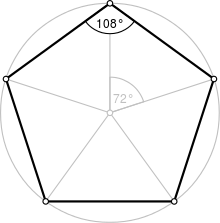Pentagon - Simple English Wikipedia, the free encyclopedia

A pentagon is a polygon with five edges. It is defined by five points, which are all on a plane. If all the edges have the same length and the angles at the corners are all 108°, the pentagon is called regular. If the pentagon intersects itself, it is called a pentagram.
Pentagons also occur in nature: Fruits of the Okra are pentangular. The flowers of Ipomoea are pentagular. In chemistry, many Cyclic compounds are pentangles: Cyclopentane and Furan are examples for this. In architecture, many bastions are pentangular: Bourtange, in the Netherlands has been completely restored, and is a pentangle. The Citadel of Lille, Nyenschantz, near St. Petersburg, or the Citadel of Pamplona are . The Villa Farnese is a palace in the form of a pentagon, so is the castle of Nowy Wiśnicz. The Pilgrimage Church of Saint John of Nepomuk near Žďár nad Sázavou also uses a pentangular design.
Formulas
[change | change source]Note: these formulas only work for regular pentagons.
R is the radius of the circumcircle.
Examples of pentagons
[change | change source]Plants
[change | change source]- Pentagonal cross-section of okra.
- Morning glories, like many other flowers, have a pentagonal shape.
- Starfruit is another fruit with fivefold symmetry.
Animals
[change | change source]- A sea star. Many echinoderms have fivefold radial symmetry.
- An illustration of brittle stars, also echinoderms with a pentagonal shape.
Artificial
[change | change source]- The Pentagon, headquarters of the United States Department of Defense.
- Home plate of a baseball field
- Fort Bourtange,in the Netherlands


 French
French Deutsch
Deutsch








































